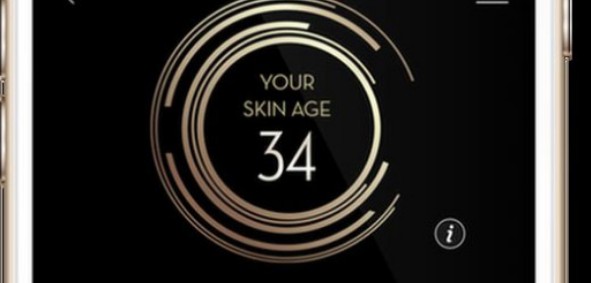1. Personalisation and AI
用人工智能实现个性化定制
According to Guive Balooch, global vice president of L'Oreal's Technology Incubator, "50% of women complain that they can't find the right shade of foundation for their face, and women with darker skin tones have been crying out for more choice."
欧莱雅高新技术创业中心全球副总裁吉夫·巴洛赫说:“50%的女性抱怨找不到色调适合自己的粉底液,而肤色暗的女性希望有更多选择。”
But putting thousands of shades on shop shelves would be "impractical", he says.
他说,然而在商店货架上摆放数千种色号的粉底液是“不现实”的。
Instead, L'Oreal subsidiary Lancome has come up with a custom-made foundation machine called Le Teint Particulier, which promises to find the "exact match" for your skin using AI.
欧莱雅旗下的兰蔻推出了一种根据客户需求定制粉底液的机器,名为肤色粉底定制仪,据说能用人工智能技术来找到“精确匹配”肤色的粉底液。
Lancome's consultants first work out your facial skin tone using a handheld colorimeter - a type of digital scanner. The results are then run through a computer, which uses a proprietary algorithm to choose from 20,000 different shades. Finally, the computer's findings are sent to a machine that mixes the foundation for you, there and then in the shop.
首先,兰蔻的咨询师会用一个手持色度计(一种数字扫描仪)测出你的脸部肤色,然后把结果输入电脑,电脑会用一种专有算法在2万种色号中做出选择。最后,电脑的计算结果将发送到一台机器,机器会当场为你在店里调制粉底液。
According to market research firm Mintel, demand for personalized cosmetics is growing fast. Nearly half of consumers like the idea that a beauty product is personalized especially for them, and a third think such products give better results.
据市场调研公司英敏特透露,个性化化妆品的需求量增长迅速。近半数顾客喜欢为自己定制专属的个性化美妆产品这个想法,三分之一的顾客认为使用这种产品效果会更好。
2. Virtual 'try on' apps
虚拟“试妆”应用
As we do more of our shopping online beauty brands are increasingly using augmented reality (AR) to enhance the experience.
随着我们网购增多,美妆品牌也越来越多地使用增强现实技术来提高我们的网购体验。
Improvements in image recognition and face tracking tech is making these digital overlays more accurate.
图像识别和面部追踪技术的改进让这些技术叠加产品的结果更加准确。
Take Sephora's Virtual Artist, which lets customers virtually try on thousands of shades of lipstick and eyeshadow through their smart phones or at kiosks in stores.
以丝芙兰的“虚拟艺术家”为例,这一应用让顾客通过智能手机或商店的化妆间虚拟试用数千种颜色的口红和眼影。
The app works by measuring where your lips and eyes are in real time, then tracking those facial feature points so it knows where to put the cosmetics.
通过实时测量你的嘴唇和眼睛的位置,这款应用追踪这些面部特征的点,从而得知在哪里上妆。
Sephora says more than 200 million shades have been tried on through Virtual Artist since it was launched in 2016, and a host of other brands, from Garnier to Germany's DM, have launched "try on" apps, too.
丝芙兰表示,自从2016年推出“虚拟艺术家”后,眼影和口红已经被试用2亿多次。包括卡尼尔和德国DM在内的多个品牌也已经推出了试妆应用。
But some reviewers warn the apps are no substitute for trying on products for real before you buy them.
不过,一些评论人士警告称,在决定是否购买时,试妆应用不能替代亲自试妆。
Maghan McDowell, innovation editor at Vogue Business, agrees they are not "100% accurate" but says customers still find them useful.
《Vogue Business》的创意编辑梅根·麦克道威尔承认这些应用的结果不是百分百准确,但顾客仍会感觉有用。
3. Smart skincare tools
智能护肤工具
Would you trust a computer to rate your skin? The HiMirror, a "smart mirror" made by Taiwan's New Kinpo Group, does just this.
你信任一台电脑来评价你的肤质吗?台湾新金宝集团制造的智能镜子HiMirror就能实现这个功能。
It takes a photo of your face every time you log in and scans it for wrinkles, red spots, pores, fine lines, and brightness levels.
每次你登录时HiMirror都会给你拍一张照片,扫描你的皱纹、红斑、毛孔、细纹和亮度。
It then rates these factors from "good" to "poor", and sends you personalized tips and product recommendations.
然后智能镜子会根据这些因素给出皮肤评级,并将个性化建议和推荐产品发送给你。
Olay offers a similar smartphone service called Skin Advisor, while its new app "FutureYou Simulation" enables users to visualize what their skin and face will look like in the future using AR.
玉兰油也提供一种类似的智能手机服务,名为“皮肤顾问”,另外玉兰油的新应用FutureYou Simulation能让用户通过增强现实技术来预见自己的皮肤和脸未来的样子。
Some skincare experts warn that, without giving users more context about their skin scores, such products could unnecessarily harm people's self-esteem if the feedback is negative.
一些护肤专家警告说,在没有提供更多背景信息的前提下,如果得到的是负面的反馈,这种给用户皮肤打分的产品会给人们的自尊心造成不必要的伤害。
4. Printed make up
打印化妆品
Will we ever see robots put on our make-up for us? A number of gadgets released in the last few years suggest we might.
有一天机器人会帮我们化妆吗?近几年推出的多个电子产品告诉我们,有可能。
Take the Opté wand from Proctor and Gamble (P&G), a make-up printer unveiled at this year's Consumer Electronics Show in Las Vegas.
以保洁公司研发的Opté wand为例,这款化妆品打印机今年在拉斯维加斯举行的消费类电子产品展览会上亮相。
The wand scans the skin and precisely applies tiny amounts of make-up to hide age spots, burst blood vessels and other blemishes.
这款打印机可扫描皮肤,精准地在皮肤上涂抹少量化妆品来遮盖色斑、血丝和其他瑕疵。
Its tiny built-in camera takes 200 frames per second, while a microprocessor analyses this data to differentiate between light and dark areas. A micro printer then applies the foundation to your skin.
打印机内置的微型摄像机秒速可达到200帧,还有一个分析数据的微处理器,可区分皮肤的亮区和暗区。微型打印机可以将粉底液涂抹到你的皮肤上。
P&G, which hopes to launch the product by 2020, says the printer's precision means it needs relatively little serum, so people's make-up bills should drop.
保洁希望在2020年前推出这一产品,并表示打印机的精准意味着需要的精华液相对更少,从而可以减少人们在化妆品上的开支。
Imagining where the trend could go, design agency Seymour Powell has unveiled a printer concept that would allow make-up looks seen online to be downloaded and printed directly on to the face.
设计工作室Seymour Powell想象了这一趋势的走向后提出了一个打印机概念,就是未来客户可以下载网上看见的妆容,并直接打印到自己的脸上。

5. 3D or 'e-make-up'
电子妆容
One of the latest beauty tech trends doesn't actually involve wearing real cosmetics.
最新的一个美妆潮流不需要用到真的化妆品。
Inspired by the craze for AR filters on Snapchat and Instagram, "e-make up" artists enable you to download outlandish make-up looks to enhance your digital self.
受Snapchat和Instagram上的增强现实滤镜热潮启发,电子化妆师让你能够下载异国风情的妆容来美化你的照片。
One artist at the forefront of the trend is Parisian Ines Marzet, known online as Ines Alpha, whose creations have adorned pictures of artists, musicians and models on Instagram.
走在潮流最前端的电子化妆师之一是来自巴黎的伊娜·玛泽(网名叫伊娜·阿尔法),Instagram上的多位艺术家、音乐人和模特都使用过她设计的妆容来美化照片。
She has also made a series of filters anyone can download for Snapchat.
伊娜还制作了一系列滤镜,任何人都可以下载后在Snapchat上使用。
The goal is to make photos and videos more shareable online, and many of her digital make-up creations have gone viral.
她的目标是让照片和视频更值得在网上被分享,她设计的许多电子妆容都是爆款。












